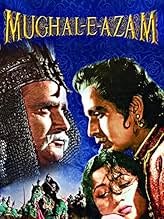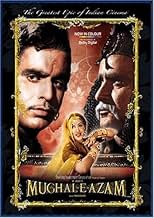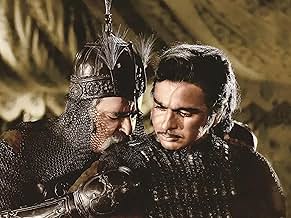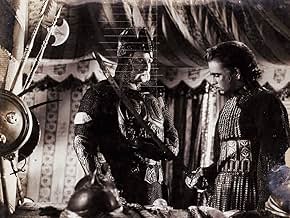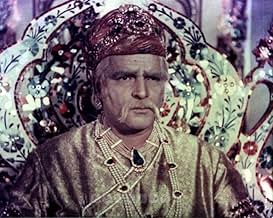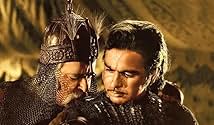NOTE IMDb
8,1/10
9,3 k
MA NOTE
Ajouter une intrigue dans votre langueA 16th century prince falls in love with a court dancer and battles with his emperor father.A 16th century prince falls in love with a court dancer and battles with his emperor father.A 16th century prince falls in love with a court dancer and battles with his emperor father.
- Réalisation
- Scénario
- Casting principal
- Récompenses
- 3 victoires et 3 nominations au total
Prithviraj Kapoor
- Emperor Akbar
- (as Prithviraj)
Ajit Khan
- Durjan Singh
- (as Ajit)
Jillo
- Anarkali's Mother
- (as Jillo Bai)
Sheila Dalaya
- Suraiya
- (as Sheela Delaya)
Tabassum Govil
- A Tawaif
- (as Baby Tabassum)
Avis à la une
A true masterpiece,featuring some of the greatest actors ever to grace the Indian screen.Prithviraj Kapoor,the doyen of Indian Cinema is Akbar himself and Dilip Kumar & Madhubala both put in sterling performances There is a question as to whether the storyline was actually true but the very nature of the story indicates the level of religious tolerance that existed at the time of Akbar.Akbar's wife Rani Jodhabhai was a hindu and that was the mughal method of building bridges with their hindu subjects.The role of Akbar would really serve as a model for religious amity today.The major issue Akbar had in consenting to the marriage of dancer Anarkali(represented by Madhubala) and Prince Salim(Dilip Kumar) was the class status.After all it was the 16th century All in all,a grand spectacle which showcases Indian culture at its very best and grandest and leaves one to wonder at the relative deterioration in subsequent centuries
This film is by far one of the best, I have seen. One is sure to be mesmerized by the love affair, the Mughal Emperor and the India of that time. The film being in Urdu language also adds originality and aura. The dialogs and direction is superb. The voice of late Prithvi Raj Kapoor as Akbar is beyond compare. Salim, played by Dilip Kumar is one of his best known acting and film. Madhubala seems great, and I definitely feel, she rivals any modern day actress in her beauty, grace and boldness and courage. I watched the latest 2004 re-release of this film in a theater and the experience was superb. I had earlier watched the movie (earlier release) in television before, but the latest release in colour and Dolby digital sound adds to the experience. Talking about a Hindi film, one definitely has to applaud it's songs. Based on Classical music, the songs adds life to the film and are strongly linked with the story-line as well. The best part I felt as a modern gen. guy is the passion and the customs and respect towards his/her duties and elders and system. Akbar's court was also known his secular principles. He had cordial relations with Rajputs(Hindu) too with his wife Jodha Bai herself being from Rajput clan and Man Singh as the head of his infantry. The movie shows the love and emotions through powerful poetic words (dialoges). This is one of the best parts of this film. One can learn many things from this film and is sure to bring in oneself an increased understanding towards one's duties and sacrifice. A must watch for one and for all ... and do watch with keenness and each word spoken in the movie is worth it.
When one thinks of great movies they remember the classics such as gone with the wind, Ben hur etc... but let us not forget one of the greatest cinematic triumphs of Hindi Cinema Mughal-e-Azam a film set in the times of the great Moughul Empire. Having seen both the part B/W and Colour and the remastered full colour version I can truly say that the colourised version truly brings out the true glory of this amazing classic putting it in a league way beyond the Classics of today. The dialogue is simply superb and the acting truly amazing modern filmmakers could learn thing or two about acting. The cinematography is simply stunning for a movie of its time. the grandeur and opulence of the sets really comes out in full colour. The story though not very relevant for modern times shows the views and attitudes of India's past. a truly great film to watch...
Mughul-E-Azam boasts of some of the highest production values employed in filmmaking in India up to that point, and the result is astounding, to say the least. The film is a true cinematic experience in terms of aesthetics, and be it the black-and-white or the colour version, it is an unforgettable visual treat. The sets, the costumes, are stunningly lavish, almost to the point of casting a gloom over the story itself. And then we have the story, an epic, poetic one, which involves a most subtle love story. The dialogue is stupendous, with many lines having a memorable, larger-than-life quality which enhances the narrative beyond imagination. The music is similarly fantastic, with spectacularly performed dance numbers. Needless to say, "Pyar Kiya To Darna Kya" is the high-point of the film and the story it tells. Prithviraj Kapoor is excellent in a wonderfully dramatic and appropriately theatrical performance as Emperor Akbar. Dilip Kumar seems to enjoy his own, mere presence, while underplaying his role to great effect. It is Madhubala, however, who walks away with the most fully-realised part of Anarkali, a slave girl whose dignity cannot be taken away at any cost. I found the film a greatly entertaining watch, and while I had a problem with its overlong running time, as well as some faulty sequences, such as the less convincing battle between the father and son, Mughul-E-Azam remains a meticulous piece of art, and a rightly-touted all-time classic of Indian cinema.
Mughal-e-Azam is indeed a colossal of a movie and its spell binding appeal and courtly grandeur has been further enhanced by the recently released color version.
Dilip Kumar, the icon of Indian Cinema and its first super star as well, has rendered complete resonance to the hedonistic persona of prince Saleem. The love travails of the myth of Anarkali have been splendidly captured on the tinsel screen through the superb portrayal by both, Madhu Bala and legendary Dilip Kumar. Besides, Pirthvi RajKapoor has also projected the required prestige and magnitude to the role of Emperor Akbar. It is worth watching, another time in color scope.
Dilip Kumar, the icon of Indian Cinema and its first super star as well, has rendered complete resonance to the hedonistic persona of prince Saleem. The love travails of the myth of Anarkali have been splendidly captured on the tinsel screen through the superb portrayal by both, Madhu Bala and legendary Dilip Kumar. Besides, Pirthvi RajKapoor has also projected the required prestige and magnitude to the role of Emperor Akbar. It is worth watching, another time in color scope.
Le saviez-vous
- AnecdotesThe song "Pyar Kiya To Darna Kiya" has an unusual history to it: it cost Rs. 10 million at a time when a film would be made for less than a million; it was written and re-written 105 times by the lyricist, Shakeel Badayuni, before the music director, Naushad, could approve of it; it was shot in the renowned Sheesh Mahal (Palace of Mirrors); and in those days of sound recording, editing and mixing, as there was no way to provide the reverberation of sound, Naushad had playback singer Lata Mangeshkar sing the song in a studio bathroom.
- GaffesMusic and dancing styles from the 19th century were depicted, although the story takes place in the 16th century. For example, Thumri, a semi-classical music form developed in the 19th century, is adopted in a dance sequence in Kathak style, which is a 16th-century dance form.
- Crédits fous2004: The End Credits play the song 'Pyaar Kiya To Darna Kya' and its 1960 end credits are adjacent to the 2004 (Technicians) credits.
- Versions alternativesThe original version is in B/W and only one song 'Pyar kiya to darna kya...' was shot in color as most of the film (by the time color technology was available) was complete. This was at the end of almost 10 years that the film was being completed. However, the year 2004 re-release is re-mastered from the original B/W version to Color with Dolby Digital sound and some visual enhancements.
- ConnexionsFeatured in Century of Cinema: 100 ans de cinéma: 100 ans de cinéma indien (1996)
Meilleurs choix
Connectez-vous pour évaluer et suivre la liste de favoris afin de recevoir des recommandations personnalisées
- How long is Mughal-E-Azam?Alimenté par Alexa
Détails
Box-office
- Budget
- 15 000 000 ₹ (estimé)
- Montant brut aux États-Unis et au Canada
- 161 434 $US
- Week-end de sortie aux États-Unis et au Canada
- 60 258 $US
- 3 avr. 2005
- Montant brut mondial
- 161 434 $US
- Durée3 heures 17 minutes
- Couleur
- Mixage
- Rapport de forme
- 1.37 : 1
Contribuer à cette page
Suggérer une modification ou ajouter du contenu manquant



